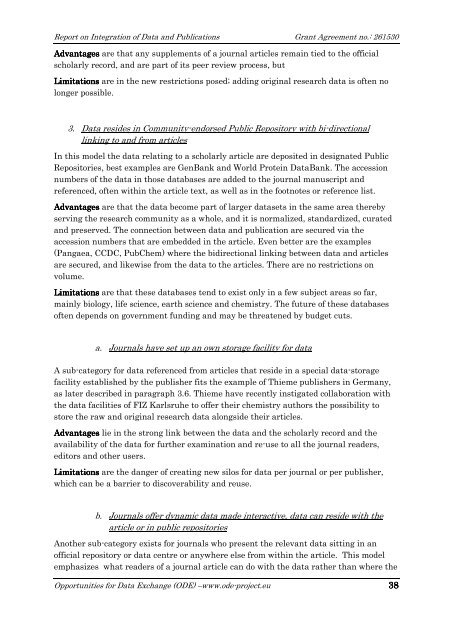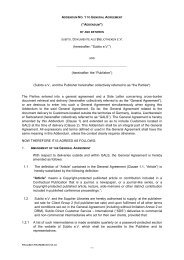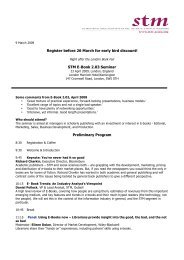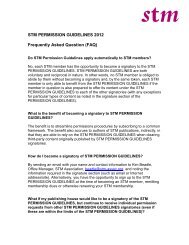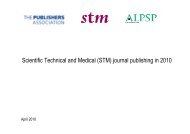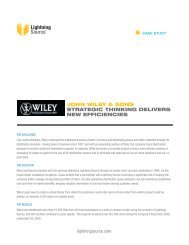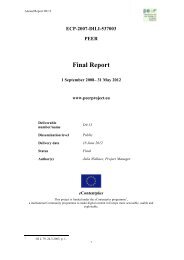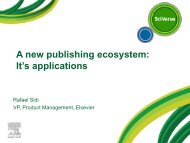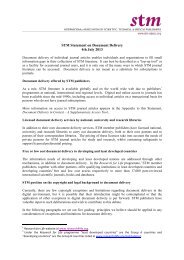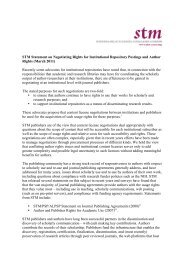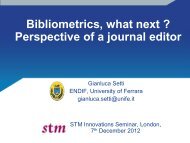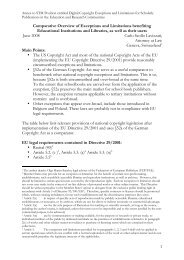Integration of Data and Publications - Alliance for Permanent Access
Integration of Data and Publications - Alliance for Permanent Access
Integration of Data and Publications - Alliance for Permanent Access
You also want an ePaper? Increase the reach of your titles
YUMPU automatically turns print PDFs into web optimized ePapers that Google loves.
Report on <strong>Integration</strong> <strong>of</strong> <strong>Data</strong> <strong>and</strong> <strong>Publications</strong> Grant Agreement no.: 261530<br />
Advantages are that any supplements <strong>of</strong> a journal articles remain tied to the <strong>of</strong>ficial<br />
scholarly record, <strong>and</strong> are part <strong>of</strong> its peer review process, but<br />
Limitations are in the new restrictions posed; adding original research data is <strong>of</strong>ten no<br />
longer possible.<br />
3. <strong>Data</strong> resides in Community-endorsed Public Repository with bi-directional<br />
linking to <strong>and</strong> from articles<br />
In this model the data relating to a scholarly article are deposited in designated Public<br />
Repositories, best examples are GenBank <strong>and</strong> World Protein <strong>Data</strong>Bank. The accession<br />
numbers <strong>of</strong> the data in those databases are added to the journal manuscript <strong>and</strong><br />
referenced, <strong>of</strong>ten within the article text, as well as in the footnotes or reference list.<br />
Advantages are that the data become part <strong>of</strong> larger datasets in the same area thereby<br />
serving the research community as a whole, <strong>and</strong> it is normalized, st<strong>and</strong>ardized, curated<br />
<strong>and</strong> preserved. The connection between data <strong>and</strong> publication are secured via the<br />
accession numbers that are embedded in the article. Even better are the examples<br />
(Pangaea, CCDC, PubChem) where the bidirectional linking between data <strong>and</strong> articles<br />
are secured, <strong>and</strong> likewise from the data to the articles. There are no restrictions on<br />
volume.<br />
Limitations are that these databases tend to exist only in a few subject areas so far,<br />
mainly biology, life science, earth science <strong>and</strong> chemistry. The future <strong>of</strong> these databases<br />
<strong>of</strong>ten depends on government funding <strong>and</strong> may be threatened by budget cuts.<br />
a. Journals have set up an own storage facility <strong>for</strong> data<br />
A sub-category <strong>for</strong> data referenced from articles that reside in a special data-storage<br />
facility established by the publisher fits the example <strong>of</strong> Thieme publishers in Germany,<br />
as later described in paragraph 3.6. Thieme have recently instigated collaboration with<br />
the data facilities <strong>of</strong> FIZ Karlsruhe to <strong>of</strong>fer their chemistry authors the possibility to<br />
store the raw <strong>and</strong> original research data alongside their articles.<br />
Advantages lie in the strong link between the data <strong>and</strong> the scholarly record <strong>and</strong> the<br />
availability <strong>of</strong> the data <strong>for</strong> further examination <strong>and</strong> re-use to all the journal readers,<br />
editors <strong>and</strong> other users.<br />
Limitations are the danger <strong>of</strong> creating new silos <strong>for</strong> data per journal or per publisher,<br />
which can be a barrier to discoverability <strong>and</strong> reuse.<br />
b. Journals <strong>of</strong>fer dynamic data made interactive, data can reside with the<br />
article or in public repositories<br />
Another sub-category exists <strong>for</strong> journals who present the relevant data sitting in an<br />
<strong>of</strong>ficial repository or data centre or anywhere else from within the article. This model<br />
emphasizes what readers <strong>of</strong> a journal article can do with the data rather than where the<br />
Opportunities <strong>for</strong> <strong>Data</strong> Exchange (ODE) –www.ode-project.eu 38


